SOL-The Emperor's New Clothes
Lately my timeline has been flooded with $SOL nonsense mixed with memecoin subterfuge. I started to believe the memecoin supercycle was real and Solana would replace Ethereum as the primary L1. But then I started digging into the data and the results were worrisome to say the least… In this post I present my findings and why Solana might be a house of cards.
First let's look at the bull case, succinctly stated by @alphawifhat :
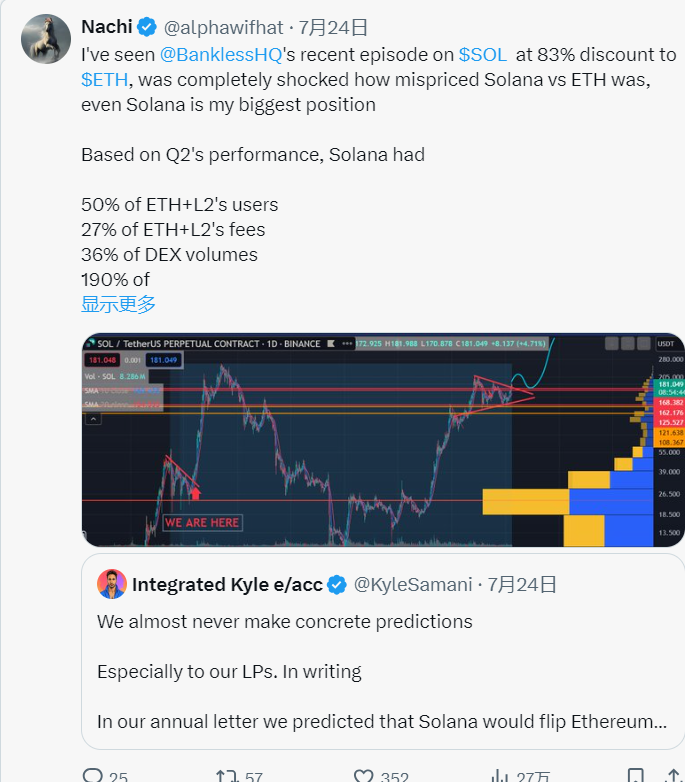
Compared to ETH plus L2s, there are four different statements on the metric:
- High percentage of user base
- The cost will increase accordingly
- DEX has high trading volume
- The proportion of stablecoin transactions has increased significantly
User group comparison:
The following is a comparison between the ETH mainnet and SOL (only comparing the mainnet, because most of the fees after Dencun come from the mainnet, source: @tokenterminal ):
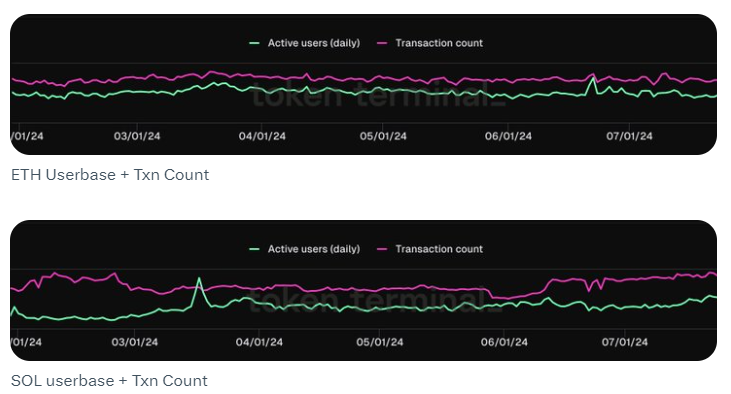
On the surface, SOL’s numbers look good, with over 1.3 million daily active users (DAU) compared to 376,300 for ETH. However, when we add the number of transactions into the mix, I noticed something odd. For example, on Friday, July 26, ETH had 1.1 million transactions and 3.763 million DAUs, which averages out to about 2.92 transactions per user per day. However, SOL had 282.2 million transactions and 1.3 million DAUs, which averages out to a whopping 217 transactions per user per day . I think this is perhaps due to low fees, allowing for more trades, more frequent compounding of positions, increased arbitrage bot activity, etc. So I compared it to another popular chain, Arbitrum. However, Arb only had 4.46 transactions/user on the same day. Looking at other chains gives similar results:
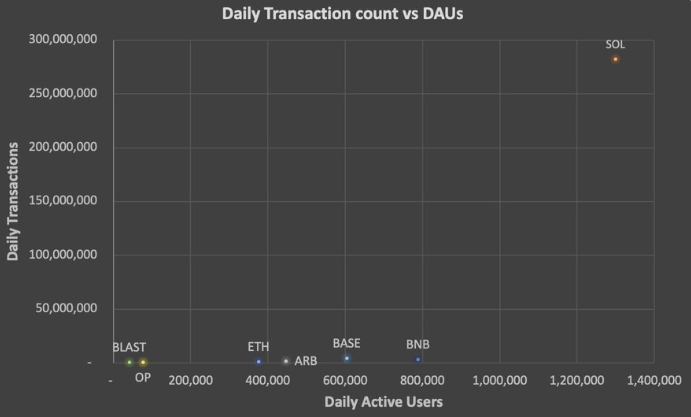
Since the number of users is higher than ETH, I checked according to Google Trends, which should be quite uncertain about the value per user:
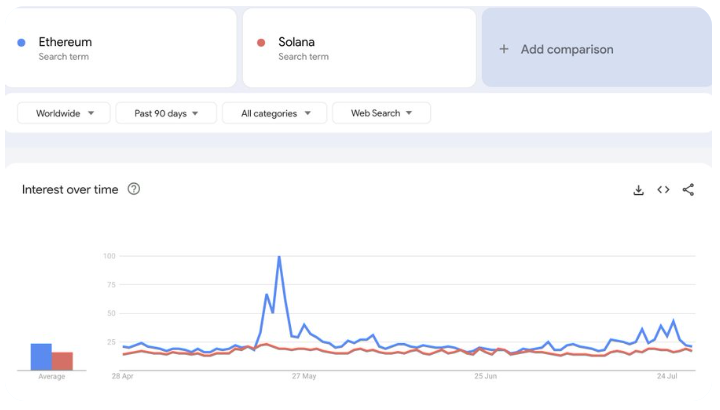
ETH is either on par with SOL or ahead of SOL. This is not what I would expect given the DAU difference, plus all the hype around the SOL memecoin trend. So what is going on?

DEX Trading Volume Analysis
To understand the discrepancy in transaction counts, it helps to look at Raydium’s LPs. Even at first glance, it’s clear that something is wrong:
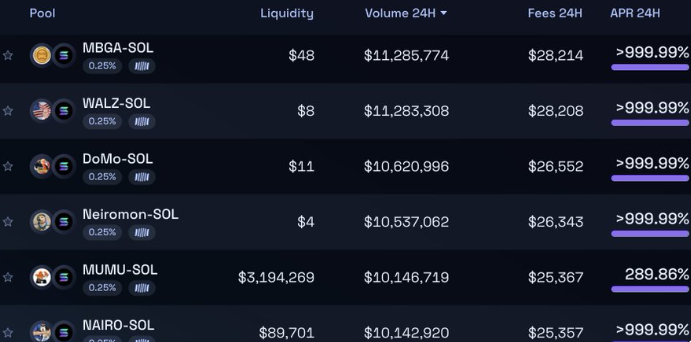
At first I thought this was just fake trading on low liquidity honeypot LPs to lure out the odd memecoin degenerate, but looking at the chart it’s much worse:
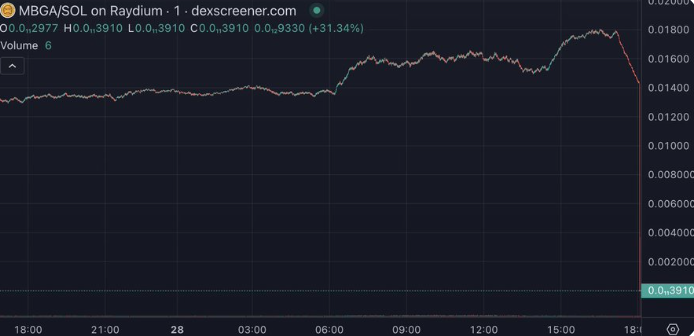
Each of these low liquidity pools is a project that has struggled to operate in the past 24 hours . Take MBGA, for example, in the past 24 hours, 46,000 trades occurred on Raydium, with $10.8M in volume, 2,845 independent wallets buying and selling, and over $28,000 in fees. (Note that a similarly sized legitimate LP, $MEW , only generated 11.2K trades) Judging from the wallets involved, the vast majority appear to be bots in the same network, with tens of thousands of trades. They independently generate fake volume, with random amounts of SOL and trades until the project is done, then move on to the next one. In the past 24 hours, there were over 50 bots with over $2.5M in volume on Raydium Standard LP, generating a total of over $200M in volume and over $500K in fees. Orca and Meteora appear to have far fewer bots, and I struggled to find any bots with any meaningful volume on Uniswap (ETH). Clearly, there is a serious problem with Solana’s carpet, which has several implications:
- Given the unusually high transaction-to-user ratio and the amount of fake/fraudulent transactions on-chain, it seems likely that the vast majority of transactions are inorganic. The highest daily transaction-to-user ratio on the main ETH L2 is 15.0x, on Blast (where fees are similarly low and users are farming Blast S2). For a rough comparison, if we assume the real SOL transaction-to-user ratio is similar to Blast, that would mean that over 93% of transactions (and fees) on Solana are inorganic .
- The only reason these scams exist is because it is profitable to do so. As a result, users lose an amount at least equal to the fees + transaction costs incurred, which can run into millions of dollars per day.
- Once deploying these scams becomes unprofitable (i.e. when actual users get tired of losing money), you’d expect most trading volume and fee revenue to decline.
- So it looks like users, organic fees, and dex volume are all grossly inflated.
I'm not the only one to come to these conclusions, @gphummer recently posted something similar:
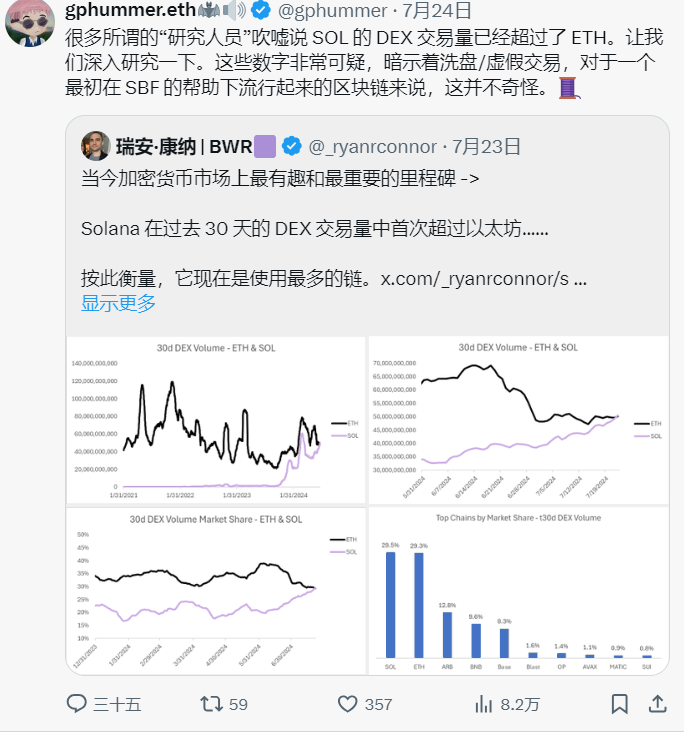
MEV on Solana
MEV on Solana is in a unique position. Unlike Ethereum, it does not have a built-in mempool; instead, code like @jito_sol created (now deprecated) extra-protocol infrastructure to emulate mempool functionality, allowing MEV opportunities such as front-running, mezzanine attacks, etc. Helius Labs put together an insightful article detailing MEV: https://www.helius.dev/blog/solana-mev-an-introduction The problem with Solana is that the vast majority of tokens traded are extremely volatile, low-liquidity memecoins, and traders often set trade slippage to >10% to ensure successful execution. This provides a lucrative attack surface for MEV to extract value:
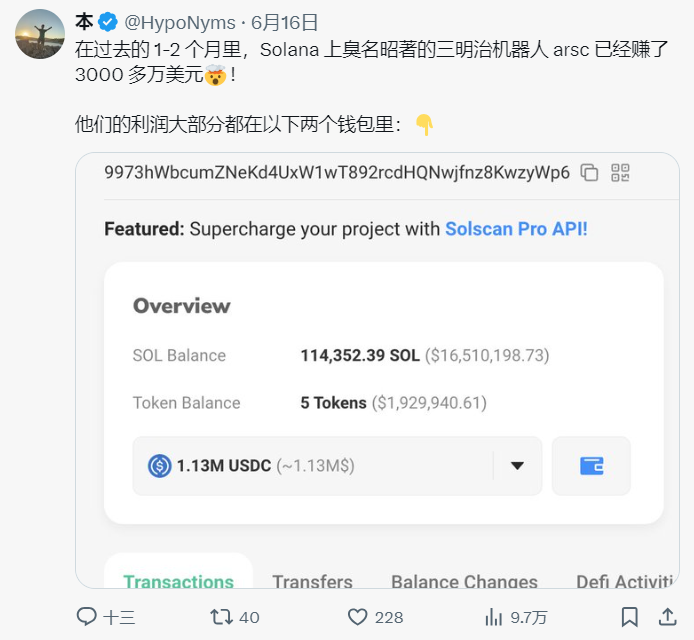
If we look at the profitability of block space, it’s clear that most of the value now comes from MEV Tip:

While this is “real” value in the strictest sense, MEV will only be implemented as long as it is profitable, i.e. as long as retail continues to imitate (and net lose money on) the meme. Once the meme starts to cool, MEV fee revenue will also collapse. I see a lot of SOL papers discussing how infrastructure builds will eventually rotate out, like $JUP , $UN , etc. This is very likely, but it is worth noting that they have lower volatility, higher liquidity, and simply do not provide the same MEV opportunities. Experienced players will be incentivized to build the best infrastructure to take advantage of this situation. During my digging, some sources mentioned rumors of these players investing in controlling mempool space and then selling access to third parties. But I was unable to confirm this information. However, there are some obvious perverse incentives here - by directing as much memecoin activity as possible to SOL, it allows savvy individuals to continue to profit from MEV, insider trading of said meme, and SOL price appreciation.
Stablecoins
Speaking of stablecoin volume + TVL, here’s another oddity. Volume is significantly higher than ETH, but when we look at @DefiLlama stablecoin data, ETH has $80B in stablecoin TVL, while SOL only has $3.2B. I think stablecoin (and more broadly) TVL is a harder metric to manipulate than volume/fees on low-fee platforms, and just shows how much skin is in the game. Stablecoin volume dynamics highlight this - @WazzCrypto noticed the sudden drop in volume after the CFTC announced its investigation into Jump:
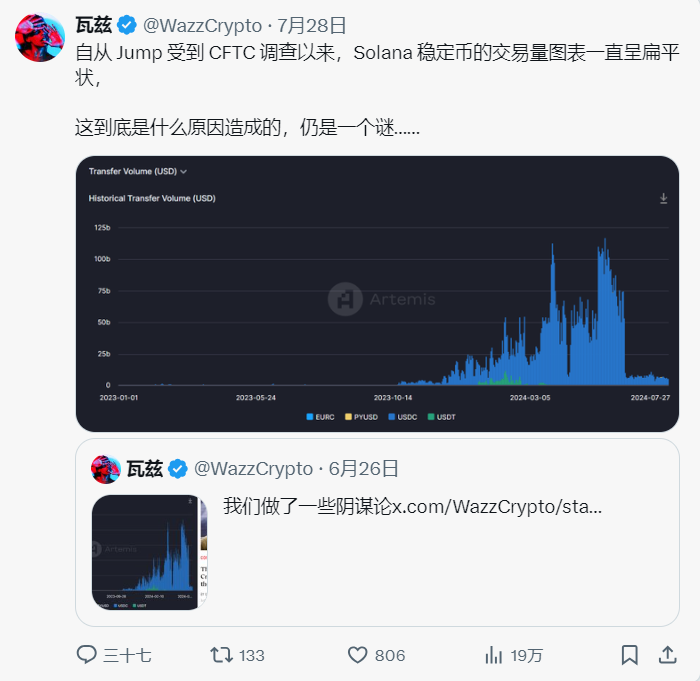
Retail value extraction
Carpets and MEVs aside, the outlook for retail remains bleak. Celebrities chose Solana as their chain of choice, but the results were not encouraging:
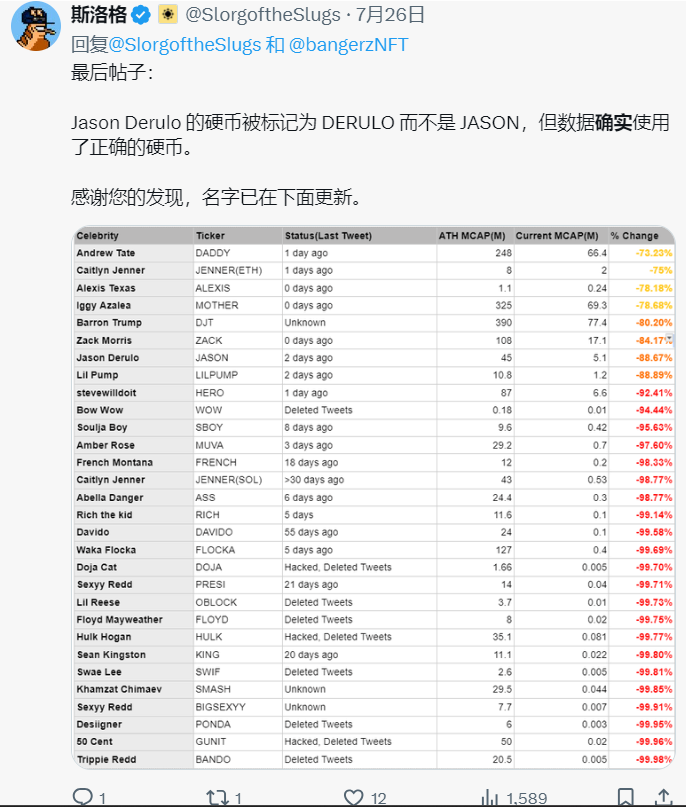
Andrew Tate’s DADDY was the best performing celebrity token with a return of -73%. Things weren’t much better at the other end of the boxing skill spectrum:
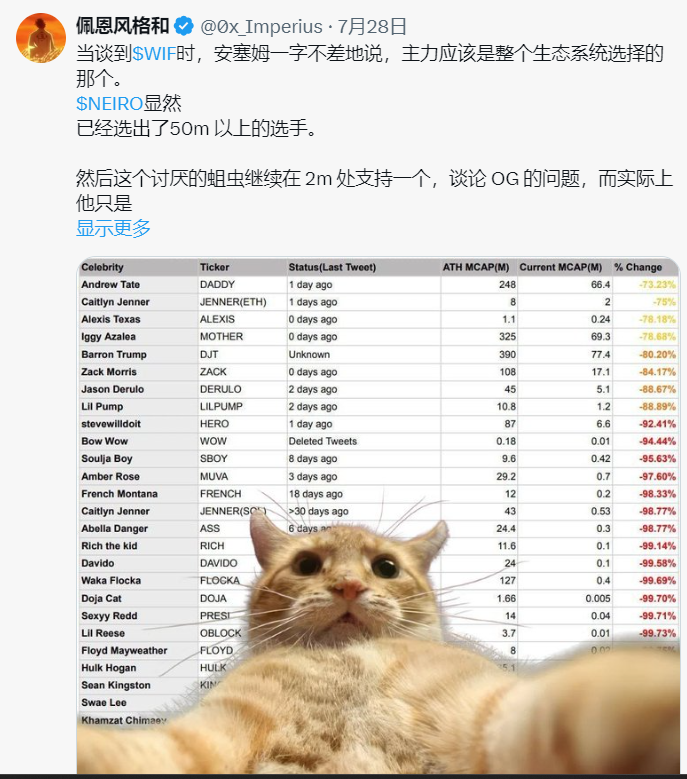
A quick search on X also reveals evidence of rampant insider trading and developers dumping on buyers:
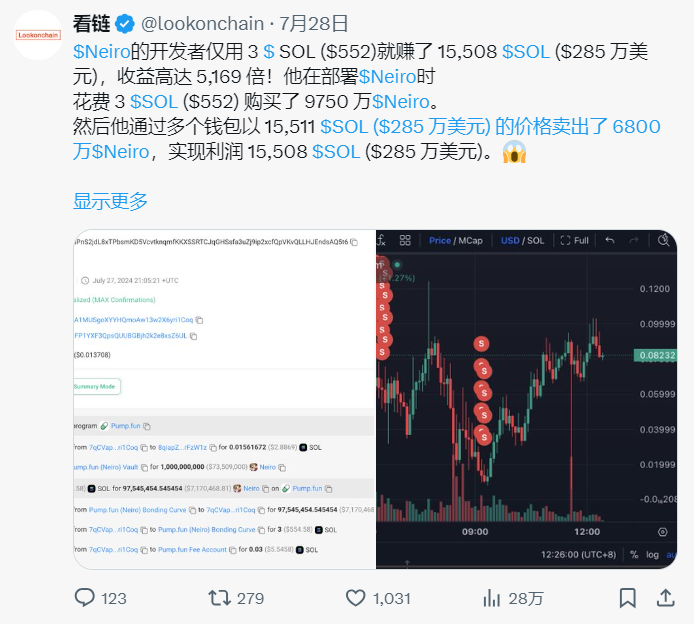
But Flip, my timeline is full of people making millions trading memes on Solana. What does that have to do with what you’re saying?
I simply don’t believe a KOL’s post on X is representative of the broader user base. With the current frenzy, it’s easy for them to get into a position, promote their token, profit from their followers, and repeat the process. There is definitely survivorship bias here - the voices of the winners are far louder than the losers, creating a distorted view of reality. Objectively speaking, retail investors seem to be losing millions of dollars every day to scammers, developers, insiders, MEV, KOLs, and that’s not even taking into account that most of what they’re trading on Solana is just memes with no substance to back it up . It’s hard to deny that most memes will eventually go to the $ floor .
Other considerations
Markets change rapidly, and when sentiment shifts, factors that were once blind to buyers become clear:
- Poor chain stability and frequent interruptions
- High transaction failure rate
- Unable to read browser
- The development threshold is high, and Rust is far less user-friendly than Solidity
- Poor interoperability compared to the EVM. I believe that having multiple interoperable chains competing for our attention is much healthier than being tied to a single (fairly centralized) chain.
- The likelihood of an ETF is low both from a regulatory perspective and from a demand perspective. The article itself highlights why institutional demand will be low in Solana’s current state. @malekanom also highlights a few points that I think are relevant from a traditional finance perspective (along with @0xmert ):

- Emissions up to 67,000 SOL/day ($12.4 million)
- There are still 41 million SOL ($7.6 billion) locked in the FTX Estate sale. 7.5 million ($1.4 billion) will unlock in March 2025, and an additional 609,000 ($113 million) will unlock each month until 2028. Most tokens appear to be available for purchase at around $64 each.
in conclusion
As always, those who sold picks and shovels profited from the Solana memecoin craze, while speculators got washed out, often without knowing it. I believe that commonly quoted metrics for SOL are grossly overstated. Furthermore, the vast majority of organic users are losing on-chain funds to bad actors at a rapid rate. We are currently in the mania phase, and retail inflows are still outstripping outflows from these sophisticated players, which is bullish. Once users become exhausted by continued losses, many metrics will quickly break down. As mentioned above, SOL also faces some fundamental headwinds that will become prominent once sentiment shifts. Any price increase will increase inflationary pressures/unlocks. Ultimately, I believe SOL is overvalued from a fundamental perspective, and while existing sentiment + momentum may drive price higher in the short term, the long-term outlook is more uncertain. Disclaimer : While I have held SOL at multiple times in the past, I do not currently hold a material position in SOL. Many of the points I make above are my own speculation and are not facts. My assumptions and conclusions may be wrong. Always exercise caution - This is not financial advice.







